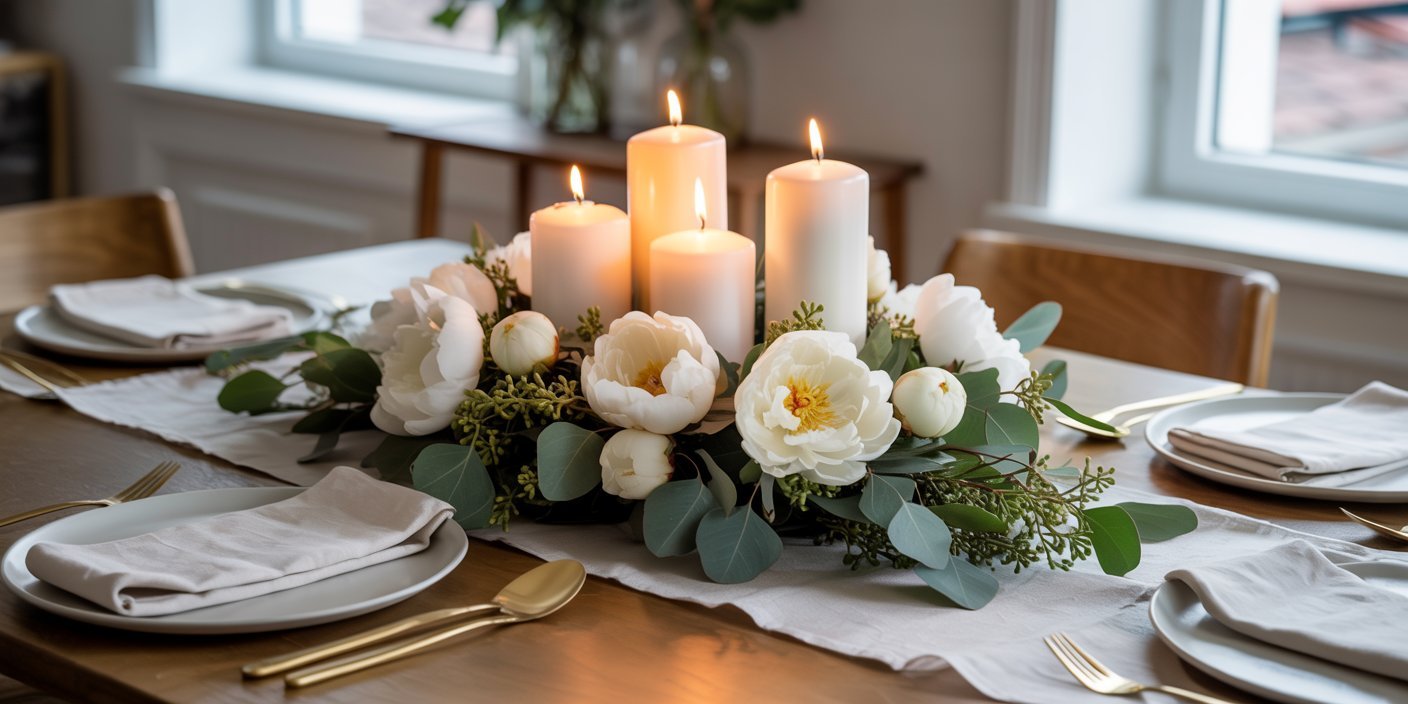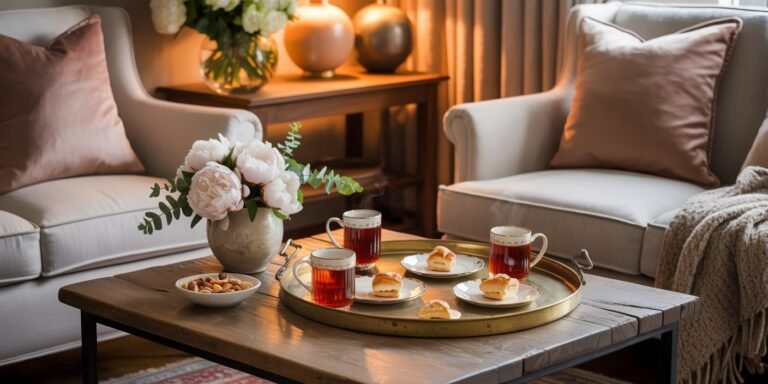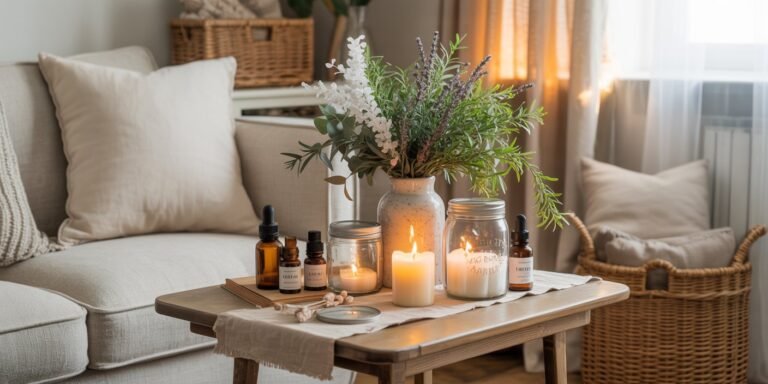There’s something about a beautifully styled dining table that sets the tone for an entire home.
It’s more than just a place to eat—it’s where conversations linger, where coffee turns into catch-ups, and where every celebration begins.
For years, I kept my dining table bare, thinking it would just collect clutter.
But one day, while scrolling through photos of cozy, inviting dining rooms, I realized that what made them so warm wasn’t the size of the space—it was the thoughtful details, especially the centerpiece.
So, I started small. A single vase of flowers at first, then candles, then seasonal pieces like pinecones and citrus slices. Before long, I had created a dining table setup that felt like “me.”
Whether I was hosting friends for dinner or enjoying a quiet solo meal, the atmosphere instantly felt elevated. It didn’t look staged or fancy—it looked lived-in, loved, and intentional.
The best part? You don’t need to be an interior designer or spend a lot of money to create that same feeling.
These 7 beautiful dining table centerpiece ideas are all easy to recreate, adaptable to your home’s style, and guaranteed to make your dining area feel warm, stylish, and welcoming.
1. The Classic Floral Arrangement
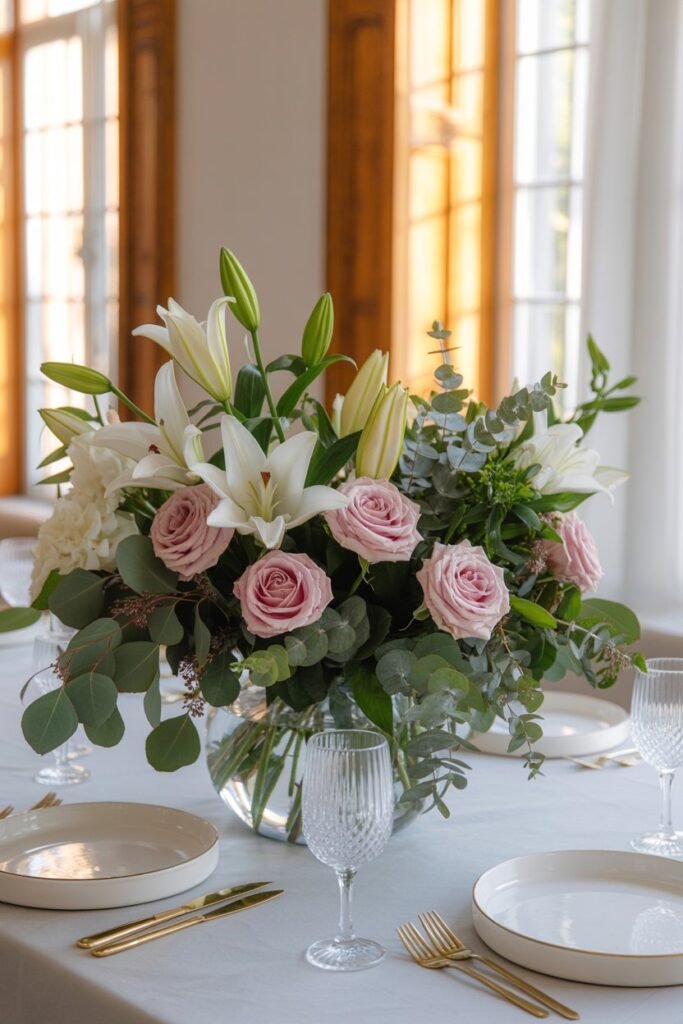
Fresh flowers are a centerpiece staple for a reason—they bring color, texture, and life into a space instantly.
Whether you prefer bold blooms like peonies and lilies or soft neutrals like white roses and eucalyptus, flowers have a way of making any meal feel a little more special.
When I first started experimenting with floral centerpieces, I made the mistake of choosing flowers that were too tall or too busy.
The result? My guests couldn’t see each other over the arrangement, and the petals were dropping before the night was over.
Over time, I learned that the secret to a great floral centerpiece is balance—both in size and simplicity.
How to Style:
Choose a vase that fits your table’s proportions. For long rectangular tables, use an elongated or low vessel so the flowers spread out evenly.
For round or square tables, a medium-height vase works beautifully. Always cut stems at an angle before placing them in water—this helps them absorb moisture and stay fresh longer.
Start with your greenery or filler flowers first, creating a loose shape. Then, layer in your main blooms, keeping the tallest stems toward the center.
Rotate the vase as you go to make sure it looks balanced from every side.
Pro Tip: Mix in a few dried or faux stems for texture and longevity. And if you’re using strong-scented flowers, keep them mild enough that they don’t overpower your dining space.
2. Candlelight and Simplicity
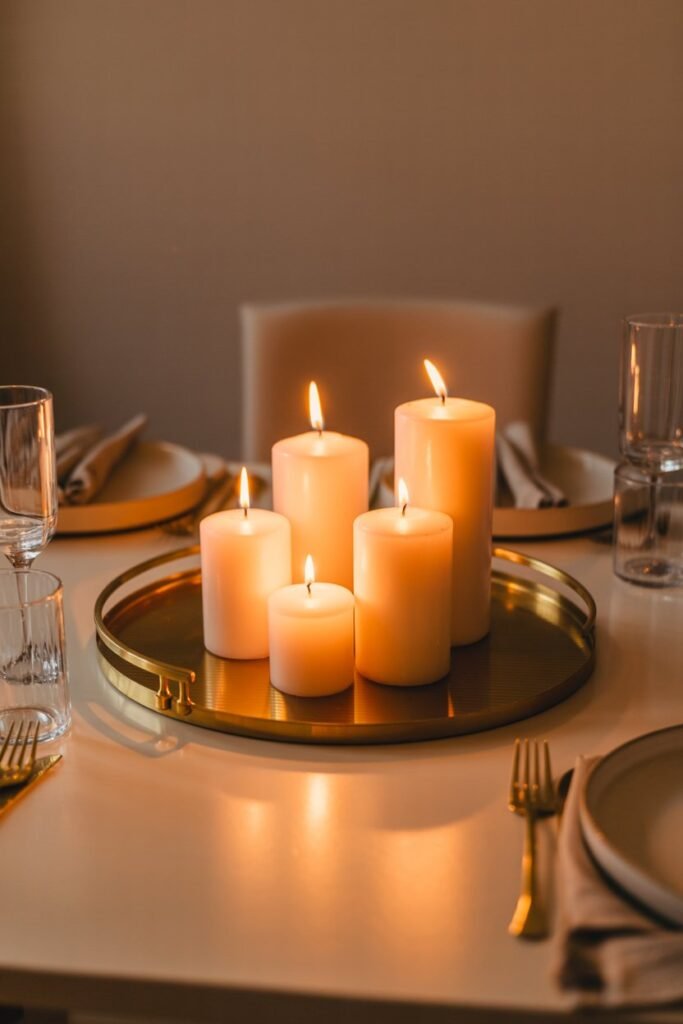
There’s nothing more effortlessly elegant than candlelight. It has this natural ability to soften a space and make it feel instantly cozy and inviting.
I remember one evening when a power outage turned dinner into an impromptu candlelit gathering.
Without meaning to, I had created the most relaxing dinner setting I’d ever experienced—and from that day forward, candles became a permanent part of my dining table.
Whether you prefer slim taper candles in vintage holders or chunky pillar candles on wooden stands, they all work beautifully.
You can go for a monochromatic look with white or ivory candles, or introduce warmth with deep hues like amber, sage, or terracotta.
How to Style:
For an easy arrangement, group candles of varying heights in odd numbers—three, five, or seven—down the center of your table.
Place them on a table runner or a narrow wooden tray to keep the look contained and polished.
You can also sprinkle in small votives or tea lights between them for added sparkle.
If you’re hosting a dinner, light them about 15 minutes before guests arrive so the wax begins to melt and the room feels instantly cozy.
Pro Tip: Always use unscented candles during meals. They’ll add warmth and ambiance without competing with the smell of your food.
For an extra polished look, choose candle holders in similar finishes—brass, black metal, or glass—to tie the display together.
3. Greenery Garland Centerpiece
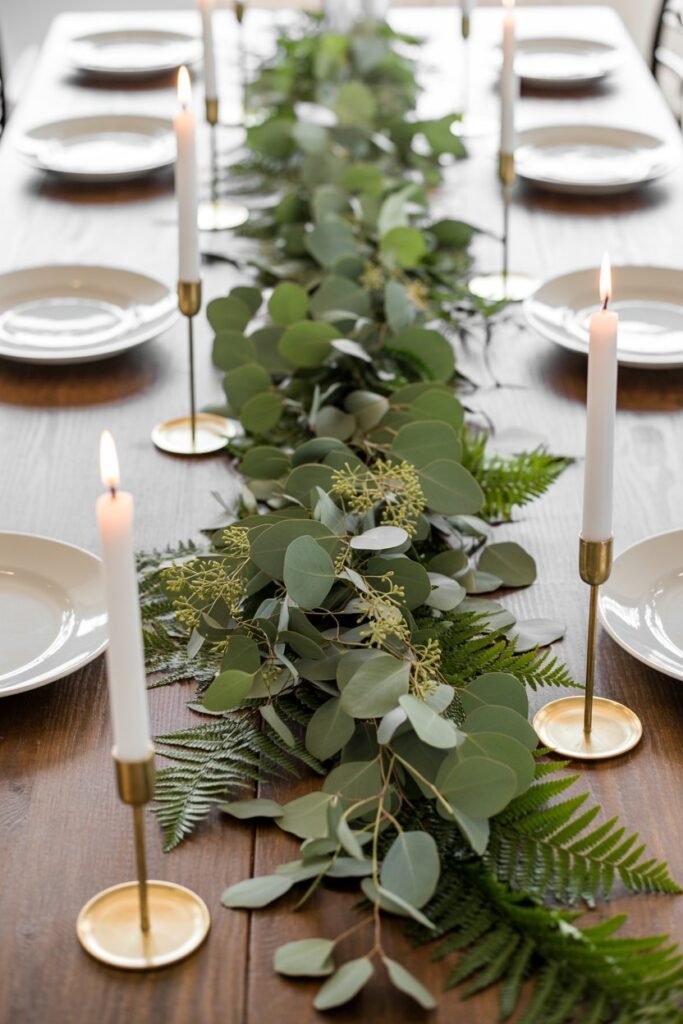
For those who love a natural, earthy aesthetic, a greenery garland is one of the easiest and most stunning centerpiece ideas. It gives your table an organic, lush look that works year-round.
I first created one during the holidays, using eucalyptus and pine, and loved it so much that I adapted it for every season afterward.
The beauty of a garland is that it’s flexible—you can make it full and dramatic for festive occasions or simple and minimal for everyday dining.
It works equally well in modern, rustic, or farmhouse interiors, adding that “just right” amount of texture without overwhelming the space.
How to Style:
Lay your garland directly along the center of your dining table.
If you’re using fresh greenery like eucalyptus or olive branches, start by placing the stems in opposite directions so the leaves naturally overlap. Secure them lightly with floral wire or twine if needed.
Once your greenery is in place, you can personalize it with seasonal accents—like small pumpkins in the fall, pinecones in the winter, or fresh flowers during spring.
If you want a touch of glow, weave in fairy lights or nestle candles along the garland for an elegant, softly lit finish.
Pro Tip: To keep fresh greenery vibrant, mist it with water every couple of days. For a low-maintenance option, high-quality faux garlands look just as stunning and can be reused throughout the year.
4. Minimalist Bowl Arrangement
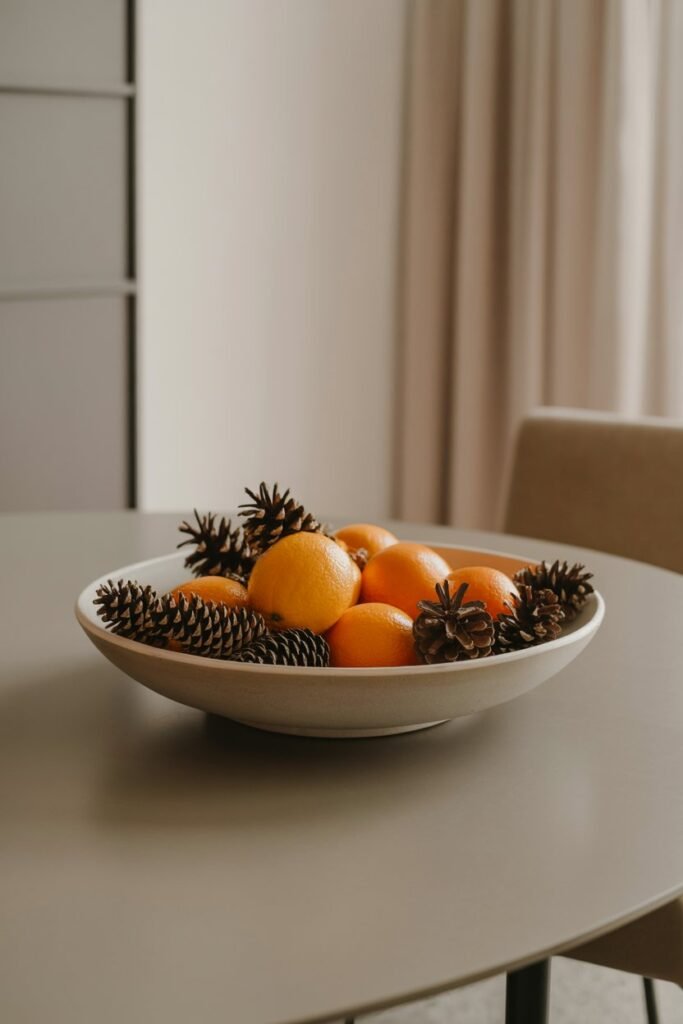
Sometimes, less truly is more. I discovered the beauty of minimalist décor during a phase when I was trying to simplify my home.
I wanted to keep things uncluttered yet elegant—and that’s when I started using decorative bowls as centerpieces.
A single, well-chosen bowl filled with seasonal items can make just as much of a statement as an elaborate setup. In the spring, I fill mine with lemons or limes for a burst of freshness.
During fall, I switch to pinecones or small pumpkins. And in winter, I love adding ornaments, dried fruit slices, and a few cinnamon sticks for warmth and texture.
How to Style:
Choose a bowl that complements your table—ceramic or glass for modern looks, and wooden or rattan for rustic styles.
Add fillers that reflect the season or your home’s color palette. Keep it cohesive by sticking to two or three tones.
Pro Tip: Don’t overfill the bowl. Leave some negative space so the centerpiece feels intentional and calm rather than busy or overwhelming.
5. Layered Tray Display
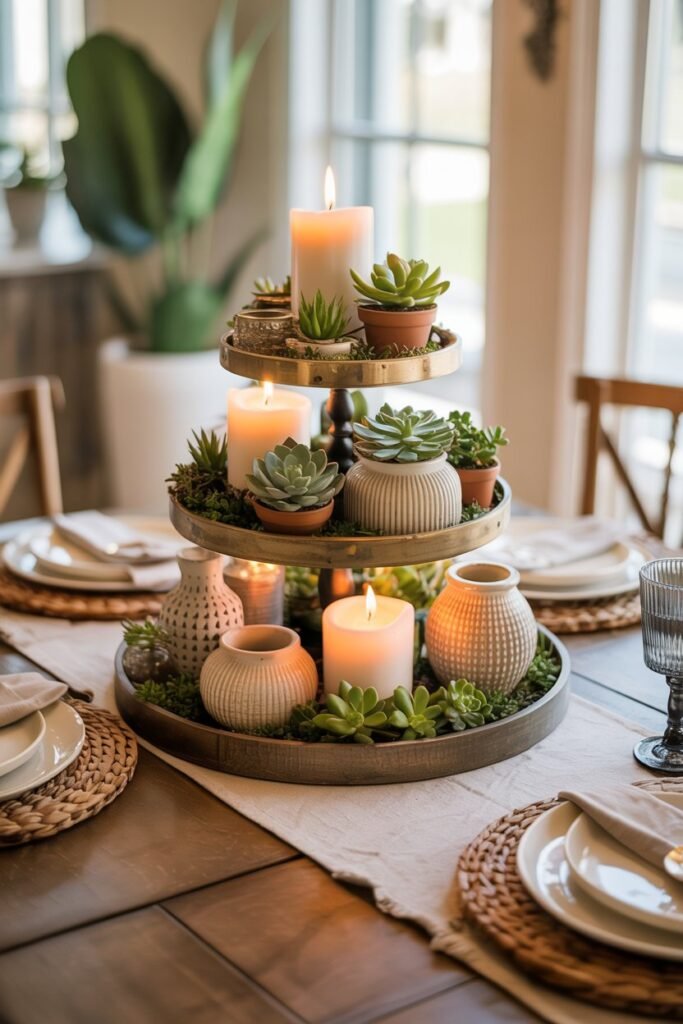
The layered tray centerpiece has become one of my absolute favorites. It’s both functional and stylish—perfect if you like changing up your décor frequently.
I often use a wooden or metal tray as a base, and then build layers with candles, vases, coasters, or small plants.
The beauty of this idea is flexibility. You can easily move it when setting the table or swap items for different moods or seasons. It gives that curated, cozy feel without much effort.
How to Style:
Start with a large tray that fits comfortably in the center of your table. Add height by using items of varying sizes—perhaps a tall vase, a mid-height candle, and a small decorative item like a ceramic bird or glass bead jar.
Balance the layout diagonally so the eye moves smoothly across the tray.
Pro Tip: Stick to a consistent color palette to avoid visual clutter. If your dining space already has a lot of texture (like wooden furniture or patterned chairs), keep your tray display simple and neutral for harmony.
6. Seasonal Centerpieces
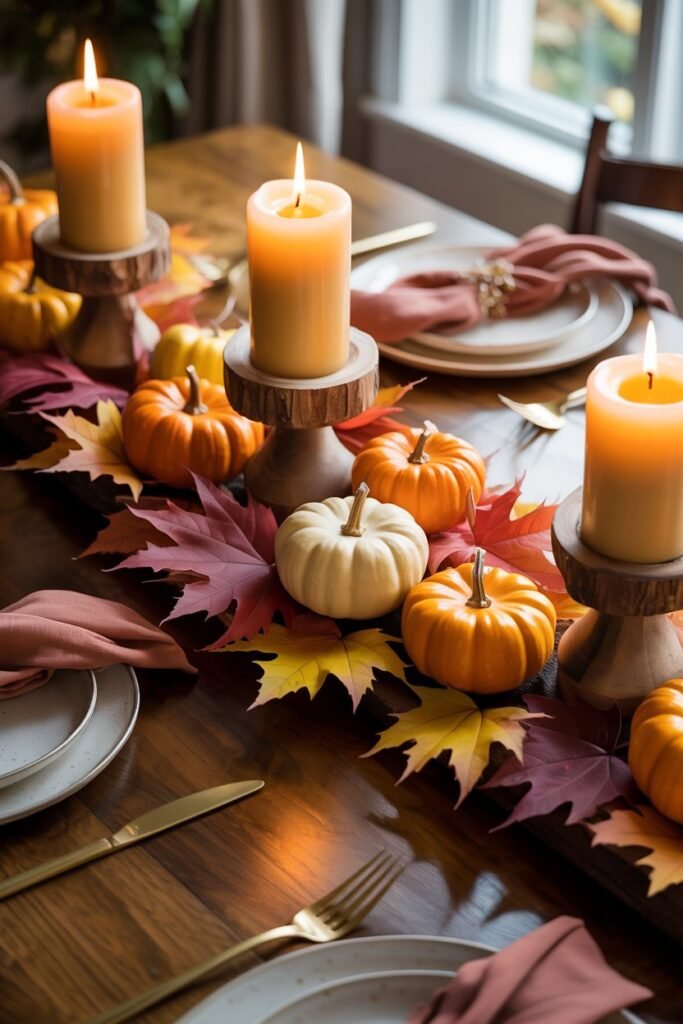
One of the easiest ways to keep your dining area feeling fresh is to rotate your centerpiece with the seasons. This approach keeps your décor exciting, and it’s a wonderful way to celebrate changing moods throughout the year.
In spring, I love pastel tones and soft florals—think tulips, daisies, and small succulents. Summer calls for light, airy pieces like fresh lemons in a glass bowl or tropical greenery.
Fall is my favorite, with amber glass, dried leaves, and earthy textures. And in winter, a mix of pine, candles, and metallic accents makes everything feel cozy and festive.
How to Style:
Pick one key theme for each season and build around it. Use natural materials as much as possible—branches, fruit, shells, or flowers all create authentic charm. Keep the base neutral so your accents stand out.
Pro Tip: If storage space is limited, choose a few core items (like a tray, vase, or candle holders) and simply rotate the fillers or colors each season instead of buying new pieces every time.
7. Books, Art, and Personal Touches
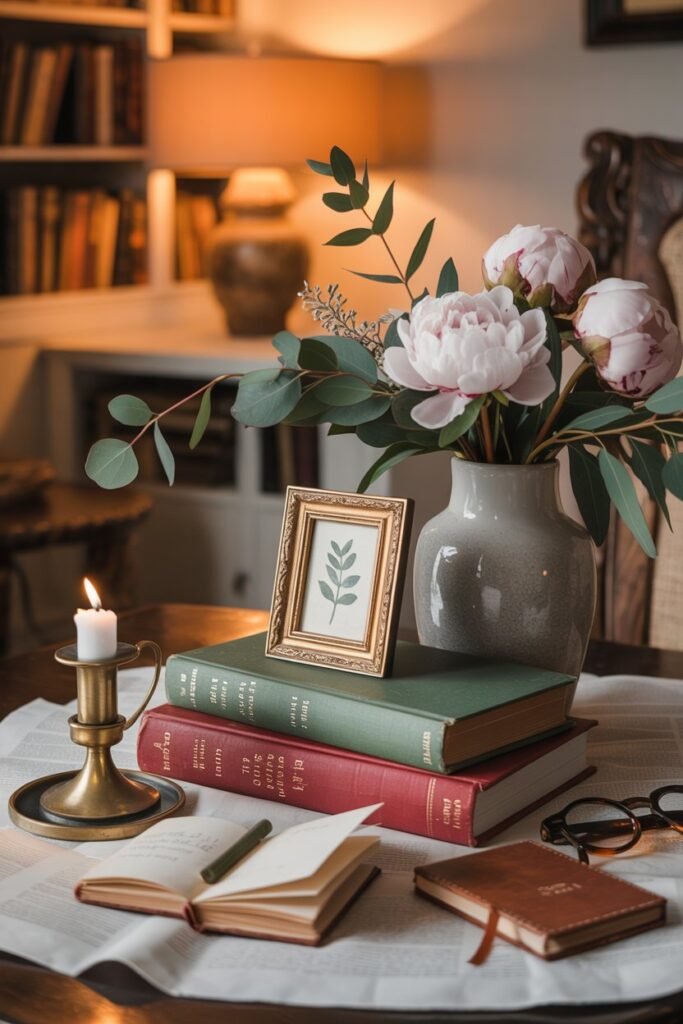
If you love décor that feels personal and lived-in, try incorporating elements that reflect your story.
Some of my favorite centerpieces have come from mixing practical items with sentimental ones—like a stack of coffee table books topped with a small plant, or a framed photo leaning against a vase.
This style works beautifully for people who enjoy creativity and want their space to feel meaningful rather than overly styled.
It’s an opportunity to express yourself through your décor—showing pieces that tell who you are, what you love, and where you’ve been.
How to Style:
Stack two or three decorative books in the center, add a candle or vase on top for height, and layer in smaller accents like a trinket dish or a decorative bead garland.
Choose neutral tones if you want a calm look, or bold covers if you prefer a splash of color.
Pro Tip: Keep proportions in mind. The goal is a cohesive display, not a cluttered pile. Leave some open space on the table so your arrangement feels airy and intentional.
Final Thoughts
Styling a console or dining table doesn’t need to feel intimidating. The trick is to play with balance, texture, and a few pieces that genuinely speak to your style.
I’ve learned that the most beautiful spaces aren’t perfect—they’re personal. Each centerpiece idea here offers a different way to bring warmth and personality into your dining room.
Whether you lean toward classic flowers, natural greenery, or cozy candlelight, the key is to make your table feel inviting and alive.
Start small, experiment, and have fun with it—because when your dining table looks beautiful, it becomes more than a place to eat. It becomes a space where moments linger.
FAQ
1. How can I make my dining table centerpiece look balanced?
Keep your centerpiece proportionate to the table size and vary the heights of your elements.
Always step back and view it from different angles to ensure symmetry and flow.
2. How often should I change my table centerpiece?
You can update it seasonally or whenever you feel like refreshing your space. Even small tweaks—like swapping flowers or candles—can make a big difference.
3. What’s the easiest centerpiece idea for beginners?
Start with a tray centerpiece. It’s simple to arrange, easy to move, and lets you experiment without overthinking.

